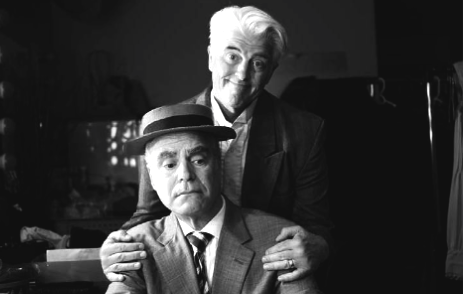By all accounts, Charlie Chaplin was a monomaniac. The actor, director and writer was so dedicated to his cinematic vision that he often put his cast members through hundreds of takes of the briefest scenes. In the case of his 1952 film Limelight, he wrote an entire novella beforehand to immerse himself fully in the semi-autobiographical story.
The making of that film inspired Greg Lam to write Chaplin and Keaton on the Set of Limelight, a new play opening at Pear Theatre this week. The world premiere production finds its magic in the juxtaposition of Chaplin (played by David Scott) alongside another silent cinema legend, Buster Keaton (played by David Boyll). The play traces the evolution—and eventual clash—of the two comic geniuses’ views on the role of humor in art and life.
Limelight marks the first and only time Charlie Chaplin and Buster Keaton appeared together in the same film. Chaplin—the writer/director/composer/actor extraordinaire—plays a washed-up clown who forms a friendship with a suicidal ballerina. At the end of the film, his character reunites with an old comedian friend for a final performance. For the role, Chaplin called in Keaton, who had fallen on hard times and was getting by with work in Parisian circuses.
“There’s a moment in the play that made me say yes to directing it,” says director Sinohui Hinojosa, whose career has spanned both film and theater. “Charles is telling Buster, ‘I don’t see you making movies. I haven’t seen you in 15 years. I don’t know why you haven’t made anything.’ And [Buster] goes, ‘I’ve been around, Charlie. You’ve been making movies. You could have called me at any point.’”
For Hinojosa and the cast, such nuanced imaginings of the way Keaton and Chaplin might have really interacted on the set of Limelight are the great thrill of the play. “It was really this whole idea of them working together, and we don’t know that much about it. What was that dynamic?” Hinojosa explains.
Historians do know at least one major element of the moment: Chaplin was under intense political scrutiny by 1952, having been accused of communist sympathies following his controversial 1940 anti-war film, The Great Dictator. “From that point forward, it felt like Charles Chaplin wanted to make a statement with everything he did,” Hinojosa says. “It was no longer about being funny.”
As the Cold War mounted, the U.S. government cracked down on free speech—all in the name of national security—throughout a time known as the Red Scare. Left-leaning artists like Chaplin faced the huge ethical dilemma of whether to censor and dilute their own voices to avoid blacklisting. Chaplin’s womanizing did not help his reputation.
“Charles Chaplin had really exceeded all the things he wanted to do, but he had a lot of problems because he’d created a lot of enemies,” Hinojosa says.
Into this tense environment walked Buster Keaton to film his scene. Known affectionately as the Great Stone Face for his deadpan demeanor, the actor simply did not approach his craft with the kind of self-importance Chaplin possessed. “One of the biggest issues was that Buster Keaton wanted to be funny,” Hinojosa says. “And you would think that’s why they brought him in—to be funny—but in some respects, he was too funny.”
This early 1950s disagreement over the nuances of humor in one film sequence may seem obscure, but it has become the stuff of cinema legend because of all the larger debates about storytelling and agency that it symbolizes. The playwright deftly manages tough questions: Can an artist become too serious, too inflexible? On the flipside, does lightness have a role in politically dark times?
For his part, Hinojosa has enjoyed the heady task of directing the story of a notorious director. He is particularly fond of a moment in the play when a character called The Girl (played by Skylar Rose Adams) loses her patience with Chaplin’s tyrannical style, exclaiming, “Why won’t you let me act?!”
“So often you have people like Chaplin that come into the directing with the idea that they have the only idea,” Hinojosa says. “I’m working with an amazing group of actors here. … I can’t have the only good idea in the room.” Together, through trial and error, he and the cast shared in the creation process.
“It literally has to be the polar opposite of what Chaplin would do,” he says of his approach.
One can’t help but wonder what Hinojosa would do if a modern-day comedian walked onto his set and started cracking jokes.
Chaplin and Keaton on the Set of Limelight
Friday, Jun 28 – Sunday, Jul 21
The Pear Theatre
1110 La Avenida St., Suite A, Mountain View
https://thepear.vbotickets.com/events
Tickets: $20 – $40




